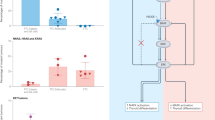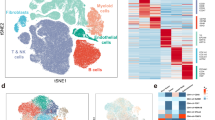Abstract
Thyroid cancer is the most frequently diagnosed endocrine cancer and causes more deaths than all other endocrine cancers combined. Research findings support the concept that a subpopulation of thyroid cancer cells displays properties characteristic of stem cells. These putative cancer-forming entities drive tumorigenesis as a result of their dual ability to undergo self-renewal and to differentiate into various types of cancer cells; they also mediate metastasis and are resistant to the effects of chemotherapy and radiation therapy. This Review discusses the cellular origin of thyroid cancer and the properties of the thyroid cancer stem cell niche. The article critically evaluates the methods used to identify molecular markers expressed by thyroid-cancer-initiating cells and outlines prospective therapeutic strategies to directly target these cells. Stem-cell technology offers an unprecedented opportunity to investigate these crucial cancer stem cell populations and to advance understanding of the molecular mechanisms that control disease processes. Such knowledge could potentially lead to the development of more effective and safer treatment regimens for late-stage thyroid cancer than are currently available.
Key Points
-
The multistep carcinogenesis model suggests that well-differentiated thyroid cancer cells can transform into undifferentiated thyroid cancer cells
-
The fetal cell carcinogenesis model postulates that thyroid cancer cells are derived from remnants of fetal thyroid cells rather than from mature thyroid follicular cells
-
The cancer stem cell model predicts that a small subset of cancer cells has the ability to self-renew and to produce progenitor cells that reconstitute and sustain tumor growth
-
Cancer stem cells have been detected in several forms of thyroid cancer through the use of antigenic markers and exploitation of in vitro and in vivo stem-cell assays
-
Thyroid cancer stem cells initiate tumorigenesis, mediate metastasis and confer resistance to the currently available regimens of chemotherapy and radiation therapy
This is a preview of subscription content, access via your institution
Access options
Subscribe to this journal
Receive 12 print issues and online access
$209.00 per year
only $17.42 per issue
Buy this article
- Purchase on Springer Link
- Instant access to full article PDF
Prices may be subject to local taxes which are calculated during checkout



Similar content being viewed by others
References
Davies, L. & Welch, H. G. Increasing incidence of thyroid cancer in the United States, 1973–2002. JAMA 295, 2164–2167 (2006).
American Cancer Society. Cancer Facts & Figures 2010. American Cancer Society [online], (2010).
Takano, T. & Amino, N. Fetal cell carcinogenesis: a new hypothesis for better understanding of thyroid carcinoma. Thyroid 15, 432–438 (2005).
Todaro, M. et al. Tumorigenic and metastatic activity of human thyroid cancer stem cells. Cancer Res. 70, 8874–8885 (2010).
Pitman, K. T., Johnson, J. T. & Myers, E. N. Papillary thyroid carcinoma associated with squamous cell carcinoma of the head and neck: significance and treatment. Am. J. Otolaryngol. 17, 190–196 (1996).
Randolph, G. W., Thompson, G. B., Branovan, D. I. & Tuttle, R. M. Treatment of thyroid cancer: 2007—a basic review. Int. J. Radiat. Oncol. Biol. Phys. 69, S92–S97 (2007).
Vasko, V., Bauer, A. J., Tuttle, R. M. & Francis, G. L. Papillary and follicular thyroid cancers in children. Endocr. Dev. 10, 140–172 (2007).
Caron, N. R. & Clark, O. H. Papillary thyroid cancer. Curr. Treat. Options Oncol. 7, 309–319 (2006).
Emerick, G. T., Duh, Q. Y., Siperstein, A. E., Burrow, G. N. & Clark, O. H. Diagnosis, treatment, and outcome of follicular thyroid carcinoma. Cancer 72, 3287–3295 (1993).
Simpson, W. J. et al. Papillary and follicular thyroid cancer. Prognostic factors in 1,578 patients. Am. J. Med. 83, 479–488 (1987).
de Groot, J. W. et al. Determinants of life expectancy in medullary thyroid cancer: age does not matter. Clin. Endocrinol. (Oxf.) 65, 729–736 (2006).
Takahashi, C. & Ewen, M. E. Genetic interaction between Rb and N-ras: differentiation control and metastasis. Cancer Res. 66, 9345–9348 (2006).
Al-Rawi, M. & Wheeler, M. H. Medullary thyroid carcinoma--update and present management controversies. Ann. R. Coll. Surg. Engl. 88, 433–438 (2006).
Simpson, W. J. Anaplastic thyroid carcinoma: a new approach. Can. J. Surg. 23, 25–27 (1980).
Tan, R. K. et al. Anaplastic carcinoma of the thyroid: a 24-year experience. Head Neck 17, 41–48 (1995).
Staunton, M. D. Thyroid cancer: a multivariate analysis on influence of treatment on long-term survival. Eur. J. Surg. Oncol. 20, 613–621 (1994).
Ain, K. B. Anaplastic thyroid carcinoma: a therapeutic challenge. Semin. Surg. Oncol. 16, 64–69 (1999).
Kondo, T., Ezzat, S. & Asa, S. L. Pathogenetic mechanisms in thyroid follicular-cell neoplasia. Nat. Rev. Cancer 6, 292–306 (2006).
Venkatesh, Y. S. et al. Anaplastic carcinoma of the thyroid. A clinicopathologic study of 121 cases. Cancer 66, 321–330 (1990).
McIver, B. et al. Anaplastic thyroid carcinoma: a 50-year experience at a single institution. Surgery 130, 1028–1034 (2001).
Dumont, J. E., Lamy, F., Roger, P. & Maenhaut, C. Physiological and pathological regulation of thyroid cell proliferation and differentiation by thyrotropin and other factors. Physiol. Rev. 72, 667–697 (1992).
Nikiforova, M. N. et al. Low prevalence of BRAF mutations in radiation-induced thyroid tumors in contrast to sporadic papillary carcinomas. Cancer Lett. 209, 1–6 (2004).
Takano, T. Fetal cell carcinogenesis of the thyroid: theory and practice. Semin. Cancer Biol. 17, 233–240 (2007).
Nikiforov, Y. & Gnepp, D. R. Pediatric thyroid cancer after the Chernobyl disaster. Pathomorphologic study of 84 cases (1991–1992) from the Republic of Belarus. Cancer 74, 748–766 (1994).
Jhiang, S. M. et al. Targeted expression of the ret/PTC1 oncogene induces papillary thyroid carcinomas. Endocrinology 137, 375–378 (1996).
Portella, G. et al. Human N-ras, TRK-T1, and RET/PTC3 oncogenes, driven by a thyroglobulin promoter, differently affect the expression of differentiation markers and the proliferation of thyroid epithelial cells. Oncol. Res. 11, 421–427 (1999).
Bonnet, D. & Dick, J. E. Human acute myeloid leukemia is organized as a hierarchy that originates from a primitive hematopoietic cell. Nat. Med. 3, 730–737 (1997).
Collins, A. T., Berry, P. A., Hyde, C., Stower, M. J. & Maitland, N. J. Prospective identification of tumorigenic prostate cancer stem cells. Cancer Res. 65, 10946–10951 (2005).
Wang, X. et al. A luminal epithelial stem cell that is a cell of origin for prostate cancer. Nature 461, 495–500 (2009).
Al-Hajj, M., Wicha, M. S., Benito-Hernandez, A., Morrison, S. J. & Clarke, M. F. Prospective identification of tumorigenic breast cancer cells. Proc. Natl Acad. Sci. USA 100, 3983–3988 (2003).
Zhu, L. et al. Prominin 1 marks intestinal stem cells that are susceptible to neoplastic transformation. Nature 457, 603–607 (2009).
Singh, S. K. et al. Identification of a cancer stem cell in human brain tumors. Cancer Res. 63, 5821–5828 (2003).
Ricci-Vitiani, L. et al. Identification and expansion of human colon-cancer-initiating cells. Nature 445, 111–115 (2007).
Monzani, E. et al. Melanoma contains CD133 and ABCG2 positive cells with enhanced tumourigenic potential. Eur. J. Cancer 43, 935–946 (2007).
Klein, W. M. et al. Increased expression of stem cell markers in malignant melanoma. Mod. Pathol. 20, 102–107 (2007).
Dou, J. et al. Isolation and identification of cancer stem-like cells from murine melanoma cell lines. Cell. Mol. Immunol. 4, 467–472 (2007).
Quintana, E. et al. Efficient tumour formation by single human melanoma cells. Nature 456, 593–598 (2008).
Schatton, T. et al. Identification of cells initiating melanomas. Nature 451, 345–349 (2008).
Singh, S. K. et al. Identification of human brain tumour initiating cells. Nature 432, 396–401 (2004).
Shu, Q. et al. Direct orthotopic transplantation of fresh surgical specimen preserves CD133+ tumor cells in clinically relevant mouse models of medulloblastoma and glioma. Stem Cells 26, 1414–1424 (2008).
O'Brien, C. A., Pollett, A., Gallinger, S. & Dick, J. E. A human colon cancer cell capable of initiating tumour growth in immunodeficient mice. Nature 445, 106–110 (2007).
Miki, J. et al. Identification of putative stem cell markers, CD133 and CXCR4, in hTERT-immortalized primary nonmalignant and malignant tumor-derived human prostate epithelial cell lines and in prostate cancer specimens. Cancer Res. 67, 3153–3161 (2007).
Hermann, P. C. et al. Distinct populations of cancer stem cells determine tumor growth and metastatic activity in human pancreatic cancer. Cell Stem Cell 1, 313–323 (2007).
Beier, D. et al. CD133(+) and CD133(–) glioblastoma-derived cancer stem cells show differential growth characteristics and molecular profiles. Cancer Res. 67, 4010–4015 (2007).
Zito, G. et al. In vitro identification and characterization of CD133(pos) cancer stem-like cells in anaplastic thyroid carcinoma cell lines. PLoS ONE 3, e3544 (2008).
Friedman, S., Lu, M., Schultz, A., Thomas, D. & Lin, R. Y. CD133+ anaplastic thyroid cancer cells initiate tumors in immunodeficient mice and are regulated by thyrotropin. PLoS ONE 4, e5395 (2009).
Schweppe, R. E. et al. Deoxyribonucleic acid profiling analysis of 40 human thyroid cancer cell lines reveals cross-contamination resulting in cell line redundancy and misidentification. J. Clin. Endocrinol. Metab. 93, 4331–4341 (2008).
Hoshi, N., Kusakabe, T., Taylor, B. J. & Kimura, S. Side population cells in the mouse thyroid exhibit stem/progenitor cell-like characteristics. Endocrinology 148, 4251–4258 (2007).
Lan, L., Cui, D., Nowka, K. & Derwahl, M. Stem cells derived from goiters in adults form spheres in response to intense growth stimulation and require TSH for differentiation into thyrocytes. J. Clin. Endocrinol. Metab. 92, 3681–3688 (2007).
Mitsutake, N. et al. Characterization of side population in thyroid cancer cell lines: cancer stem-like cells are enriched partly but not exclusively. Endocrinology 148, 1797–1803 (2007).
Sullivan, P. et al. Aldehyde dehydrogenase activity selects for lung adenocarcinoma stem cells dependent on notch signaling. Cancer Res. 70, 9937–9948 (2010).
Croker, A. K. et al. High aldehyde dehydrogenase and expression of cancer stem cell markers selects for breast cancer cells with enhanced malignant and metastatic ability. J. Cell. Mol. Med. 13, 2236–2252 (2009).
Shmelkov, S. V. et al. CD133 expression is not restricted to stem cells, and both CD133+ and CD133− metastatic colon cancer cells initiate tumors. J. Clin. Invest. 118, 2111–2120 (2008).
Malaguarnera, R. et al. Insulin receptor isoforms and insulin-like growth factor receptor in human follicular cell precursors from papillary thyroid cancer and normal thyroid. J. Clin. Endocrinol. Metab. 96, 766–774 (2011).
Derwahl, M. Linking stem cells to thyroid cancer. J. Clin. Endocrinol. Metab. 96, 610–613 (2011).
Ishikawa, F. et al. Chemotherapy-resistant human AML stem cells home to and engraft within the bone-marrow endosteal region. Nat. Biotechnol. 25, 1315–1321 (2007).
Zheng, X., Cui, D., Xu, S., Brabant, G. & Derwahl, M. Doxorubicin fails to eradicate cancer stem cells derived from anaplastic thyroid carcinoma cells: characterization of resistant cells. Int. J. Oncol. 37, 307–315 (2010).
Beier, D. et al. CD133 Expression and cancer stem cells predict prognosis in high-grade oligodendroglial tumors. Brain Pathol. 18, 370–377 (2008).
Author information
Authors and Affiliations
Ethics declarations
Competing interests
The author declares no competing financial interests.
Rights and permissions
About this article
Cite this article
Lin, RY. Thyroid cancer stem cells. Nat Rev Endocrinol 7, 609–616 (2011). https://doi.org/10.1038/nrendo.2011.127
Published:
Issue Date:
DOI: https://doi.org/10.1038/nrendo.2011.127
This article is cited by
-
The potential role of reprogrammed glucose metabolism: an emerging actionable codependent target in thyroid cancer
Journal of Translational Medicine (2023)
-
The strategies to cure cancer patients by eradicating cancer stem-like cells
Molecular Cancer (2023)
-
Recapitulating thyroid cancer histotypes through engineering embryonic stem cells
Nature Communications (2023)
-
NEDD9 links anaplastic thyroid cancer stemness to chromosomal instability through integrated centrosome asymmetry and DNA sensing regulation
Oncogene (2022)
-
Alginate-based 3D cell culture technique to evaluate the half-maximal inhibitory concentration: an in vitro model of anticancer drug study for anaplastic thyroid carcinoma
Thyroid Research (2021)



